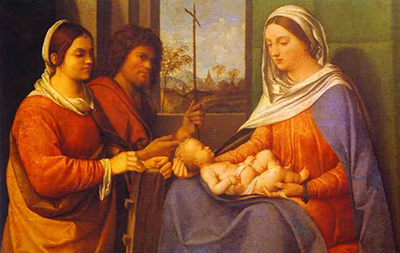Sacred conversation, also known as holy conversation or sacra conversazione, is a painting genre developed in the Italian Renaissance with a drawing of the Virgin Mary and baby Jesus in an informal group of saints.
Other pieces of art may also include kneeling saints with their patron saint presenting them to the Virgin Mary and with angels in attendance. The phrase is used to refer to certain paintings to avoid listing all the pieces of art individually. Earlier paintings depict a rapt stillness of mood, where saints, scarcely looking at each other, seem to interact at a spiritual level rather than a physical level. Later paintings have the saints facing each other and giving an impression of more interaction and conventional conversations between each other.
Giorgione, nicknamed Zorzon or the great George, created Sacred Conversation in 1505 during the High Renaissance period. In his painting, the Virgin Mary and the infant Jesus are on a dais that is slightly raised and are seated on a throne. The saints stand but the adult heads are about at the same level. This was an example of image that gave rise to the horizontal format which became common in later paintings.
This type of painting developed as painters replaced earlier polyptych, hieratic and compartmented triptych formats for altarpieces. The paintings had compositions where figures are placed upon clouds or in mid-air above the saints. Traditional art pieces however retained a vertical format where all figures are on the same level or nearly so. Early examples are the Barbadori Altarpiece by Filippo Lippi, Fiesole Altarpiece by Fra Angelico, San Marco Altarpiece and the Annalena Altarpiece. Some of these paintings rarely show a lot of interaction or actual conversation.
In the 1510s, Venetians such as Titian developed a tradition of an open landscape or outdoor settings in a field or garden. Other compositions had outdoor groups that featured angels, the Virgin, baby Jesus and saints such as Madonna and Child, and the Adoration of the Shepherds. In Giorgione's Castelfranco Madonna, the height used allowed a landscape to appear above the heads of the saints. During this period the term Hortus conclusus was coined, which referred to a painting with a group of people placed in a garden. When a painting had Virgin Mary as the subject and female saints surrounding the Virgin, it was referred to as a Virgo inter Virgines.




